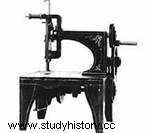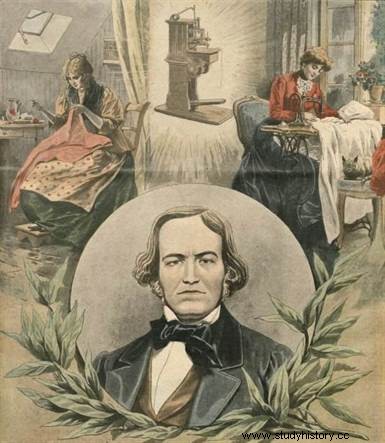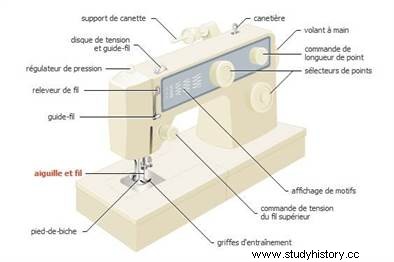 In the 19th century, there was a shift from an artisanal production system to true industrial-type manufacturing which required the use of machinery. The field of sewing is no exception to this general evolution. The invention of the sewing machine will make it possible to assemble pieces of fabric or leather by shuttle stitch or by chain stitch. If the French Thimonier is one of the first inventors of the sewing machine, it is the American Singer which will impose its name as one of the biggest sewing machine brands.
In the 19th century, there was a shift from an artisanal production system to true industrial-type manufacturing which required the use of machinery. The field of sewing is no exception to this general evolution. The invention of the sewing machine will make it possible to assemble pieces of fabric or leather by shuttle stitch or by chain stitch. If the French Thimonier is one of the first inventors of the sewing machine, it is the American Singer which will impose its name as one of the biggest sewing machine brands.
Machinism and the textile industry in the 19th century
Machinism is the use of machines. Since ancient times, men have used relatively simple devices to facilitate their work or their military operations. But the awareness of the importance of machines is especially made during the Renaissance. In the field of textiles, two major inventions modified production in the 15th and 16th centuries:the mill for pulling silk and the loom for making stockings. In the 18th century, the belief in the progress of humanity brought about by science led to the triumph of machinery. In addition, in a few decades, the irruption of steel profoundly changed civilization, which entered an industrial era.
The textile industry occupies the first place until the 18th century. With the industrial revolution, it took a back seat. However, since 1810-1815, the production of wool and cotton is constantly increasing. In 1850, that of wool was doubled while that of cotton quintupled. The needs of consumers and the number of workers have increased considerably in France as in England. In addition, the engineers are perfecting the textile technique. They design metal looms operated by steam and they imagine various processes to treat fabrics.
Invention of the sewing machine, from Thimonnier to Singer
Before the invention of the sewing machine, seamstresses and tailors could not cope with growing demand, while fabrics abounded on the market. It is therefore quite natural that one of them thinks of mechanizing the sewing.
 The first sewing machine was patented in 1790 by British inventor Thomas Saint. Saint's machine, designed to sew leather and canvas, used a single thread and formed a chain of stitches. There was no needle, but an awl was used to poke a hole in the materials to be sewn. A second mechanism placed the yarn over the hole, then a forked needle-like rod pulled it through the work, under which a hook caught it and moved it forward for the next stitch. By repeating the cycle, a second loop was formed, following the first, below the fabric, thus forming a chain and stopping the stitch. Saint's machine, however, although patented, was never commercialized.
The first sewing machine was patented in 1790 by British inventor Thomas Saint. Saint's machine, designed to sew leather and canvas, used a single thread and formed a chain of stitches. There was no needle, but an awl was used to poke a hole in the materials to be sewn. A second mechanism placed the yarn over the hole, then a forked needle-like rod pulled it through the work, under which a hook caught it and moved it forward for the next stitch. By repeating the cycle, a second loop was formed, following the first, below the fabric, thus forming a chain and stopping the stitch. Saint's machine, however, although patented, was never commercialized.
The first operational sewing machine was built in 1829 by a French tailor, Barthélemy Thimonnier. A tailor by trade, Thimonnier moved to Amplepuis, then to Saint-Étienne in 1823. From 1825 to 1829, he locked himself in a workshop during his free time to develop a machine capable of sewing alone. Completed in four years, it is operated by turning a wheel which drives the vertical movement of a needle. By piercing the fabric, it carries with it a wire that forms a loop, while a claw moves the fabric. With this system, it is possible to sew 200 stitches per minute and to embroider. Thimonnier patented his invention on April 13, 1830 and founded a factory of “couso-brodeurs” in Paris in 1831. But the tailor workers destroyed the machines for fear of finding themselves unemployed. Thimonnier then returned to Amplepuis where he perfected his discovery. In 1855, he presented his last copy at the Universal Exhibition in Paris, but he only won a second medal and ended up going bankrupt.
Sewing machine improvements
The first shuttle stitch machine was designed around 1834 by American inventor Walter Hunt. The machine, which used an eyed needle and an oscillating shuttle, was not patented at the time of its invention, and when Hunt later tried to file for a patent, his claim was denied.
 American Elias Howe places a second spool of thread:the bobbin. Introduced simultaneously into the fabric, the two threads form two loops which are tied and the stitch holds perfectly. Howe files a patent without exploiting it and returns to the United States. Another American, Isaac Merrit Singer adds a foot control and also files a patent. As his machine is very suitable for dressmakers, it is mass produced and sold.
American Elias Howe places a second spool of thread:the bobbin. Introduced simultaneously into the fabric, the two threads form two loops which are tied and the stitch holds perfectly. Howe files a patent without exploiting it and returns to the United States. Another American, Isaac Merrit Singer adds a foot control and also files a patent. As his machine is very suitable for dressmakers, it is mass produced and sold.
Other important inventions include the rotating bobbin case which was incorporated in 1850 into a machine patented by the American inventor Allen Benjamin Wilson and the intermittent device for advancing the fabric between each stitch, which was part of the same patent. The presser foot, a spring-loaded tensioning device that holds the fabric firmly to the platen, was invented by Singer after he filed a patent for his first machine.
In addition to the large number of machines available for family use, about 2,000 different types of industrial machines were designed for the manufacture of hats, shoes and hosiery, as well as only for making. Modern machines, family and industrial, are equipped with microprocessors, in charge of the automatic conduct of the sequences of operation.
To go further
- History of the sewing machine, portrait and biography of the inventor Barthélemy ThimonnierThimonnier, by J. Meyssin. BNF, 2013.
- The history of inventions. The world, 2015.
